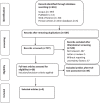Developing and validating of the Clinical Uncertainty Measurement Questionnaire (CUMQ) among practicing physicians and clinical residents in Iran
- PMID: 35710546
- PMCID: PMC9202180
- DOI: 10.1186/s12909-022-03444-1
Developing and validating of the Clinical Uncertainty Measurement Questionnaire (CUMQ) among practicing physicians and clinical residents in Iran
Abstract
Background: Despite the fact that clinicians face uncertainty in their decisions, there is no comprehensive framework to measure it in medical practices which is the knowledge gap especially for Iran. Therefore, this study aimed to evaluate the reliability and validity of a Persian questionnaire which is designed to measure different determining aspects of uncertainty from clinical physicians' perspectives in Iran.
Methods: Clinical Uncertainty Measurement Questionnaire (CUMQ) has been derived from a mixed method study since March 2019 to January 2021. To exclude raw items of the questionnaire, the literature was reviewed and in-depthinterviews were implemented with 24 residents,specialists and sub-specialists in all major clinical fields which resulted in the first theoretical uncertainty in clinical decision making framework. CUMQ content validity has been evaluated using content validity index (CVI) and content validity ratio (CVR). The structural validity of the questionnaire was assessed using confirmatory factor analysis and factor loading and t-value for each indicator of uncertainty is reported. Moreover, to analyze the research model we used the Partial Least Squares (PLS) technique using the SmartPLS software. Convergent (using Average Variance Extracted (AVEs) for each latent variable) and discriminant validity (using the criteria of Fornell and Larckerand cross loading) of the model was also evaluated. After that, the quality of the model was evaluated adjustment through predictive validity (Q2) and effect size (f2). In addition, the reliability was also assessed using Cronbach's alpha and composite reliability.
Results: The CVR and CVI ranged from 0. 80 to 1. 00 which illustrates high content validity. Out of 30 items, 24 items had acceptable factor loading and remained in the questionnaire which have been categorized as five main clinical uncertainty dimensions; general determinants, individual determinants of the physician, individual determinants of patient, dynamics of medical sciences, diagnostic and instrumental limitations. The value of composite reliability and Cronbach's alpha for all dimensions were above the threshold value of 0. 7 and the reliability has been confirmed. As AVE values were greater than 0. 5, convergent validity is confirmed. The result of Fornell-Larcker and cross-loadings also indicated that discriminant validity is well established.
Conclusion: This CUMQ is as avalid and reliable instrument and a suitable tool to measure clinical uncertainty in the Iranian Medical community. However, the reliability of this questionnaire can be studied in other languages and in other countries.
Keywords: Clinical Uncertainty; Questionnaire; Reliability; Validity.
© 2022. The Author(s).
Conflict of interest statement
None declared.
Figures
Similar articles
-
Validation of the menopause representation questionnaire (MenoSentations-Q) among Iranian women and cross-cultural comparison with Portuguese women.BMC Womens Health. 2025 Feb 25;25(1):87. doi: 10.1186/s12905-025-03606-5. BMC Womens Health. 2025. PMID: 40001061 Free PMC article.
-
Translation and psychometric evaluation of composite feedback-seeking behavior questionnaire among Iranian medical residents.BMC Med Educ. 2024 May 29;24(1):594. doi: 10.1186/s12909-024-05586-w. BMC Med Educ. 2024. PMID: 38811982 Free PMC article.
-
Psychometric properties of the persian version of the physician teaching self-efficacy questionnaire.BMC Med Educ. 2023 Mar 15;23(1):163. doi: 10.1186/s12909-023-04130-6. BMC Med Educ. 2023. PMID: 36922833 Free PMC article.
-
Psychometric properties of the physical environment problems and barriers scale in older adults' homes using an ergonomic approach.Work. 2022;73(3):1011-1022. doi: 10.3233/WOR-210983. Work. 2022. PMID: 35988247 Review.
-
[Psychometric characteristics of questionnaires designed to assess the knowledge, perceptions and practices of health care professionals with regards to alcoholic patients].Encephale. 2004 Sep-Oct;30(5):437-46. doi: 10.1016/s0013-7006(04)95458-9. Encephale. 2004. PMID: 15627048 Review. French.
Cited by
-
Translation, Cross-Cultural Adaptation, and Psychometric Validation of the Health Information Technology Usability Evaluation Scale in China: Instrument Validation Study.J Med Internet Res. 2025 May 2;27:e67948. doi: 10.2196/67948. J Med Internet Res. 2025. PMID: 40315454 Free PMC article.
References
-
- Smith M, Higgs J, Ellis E. Factors influencing clinical decision making. Clin Reason Health Prof. 2008;3:89–100.
-
- Descartes R. Meditations on first philosophy: With selections from the objections and replies. Oxford University Press; 2008;1:336–41.
MeSH terms
LinkOut - more resources
Full Text Sources
Research Materials
Miscellaneous




